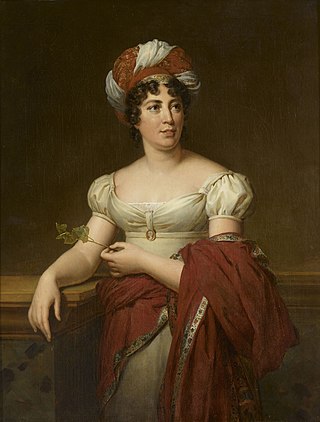
Anne Louise Germaine de Staël-Holstein, commonly known as Madame de Staël, was a prominent woman of letters and political theorist in both Parisian and Genevan intellectual circles. She was the daughter of banker and French finance minister Jacques Necker and Suzanne Curchod, a respected salonhostess. Throughout her life, she held a moderate stance during the tumultuous periods of the French Revolution and the Napoleonic era, persisting until the time of the French Restoration.
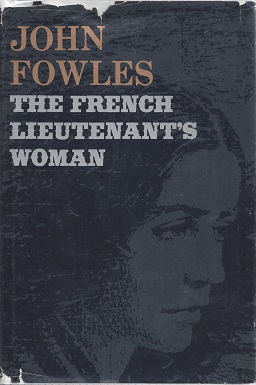
The French Lieutenant's Woman is a 1969 postmodern historical fiction novel by John Fowles. The plot explores the fraught relationship of gentleman and amateur naturalist Charles Smithson and Sarah Woodruff, the former governess and independent woman with whom he falls in love. The novel builds on Fowles' authority in Victorian literature, both following and critiquing many of the conventions of period novels.

Claire, Duchess of Duras was a French writer best known for her 1823 novel called Ourika, which examines issues of racial and sexual equality, and which inspired the 1969 John Fowles novel The French Lieutenant's Woman.
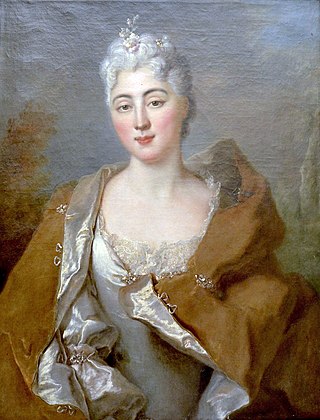
Charlotte Aïssé was a French letter-writer and the daughter of a Circassian chief.
Plaçage was a recognized extralegal system in French and Spanish slave colonies of North America by which ethnic European men entered into civil unions with non-Europeans of African, Native American and mixed-race descent. The term comes from the French placer meaning "to place with". The women were not legally recognized as wives but were known as placées; their relationships were recognized among the free people of color as mariages de la main gauche or left-handed marriages. They became institutionalized with contracts or negotiations that settled property on the woman and her children and, in some cases, gave them freedom if they were enslaved. The system flourished throughout the French and Spanish colonial periods, reaching its zenith during the latter, between 1769 and 1803.
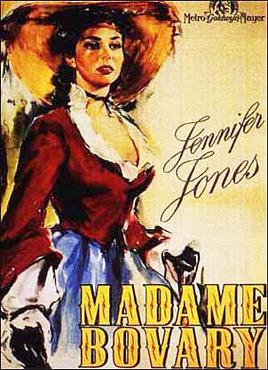
Madame Bovary is a 1949 American romantic drama, a film adaptation of the classic 1857 novel of the same name by Gustave Flaubert. It stars Jennifer Jones, James Mason, Van Heflin, Louis Jourdan, Alf Kjellin, Gene Lockhart, Frank Allenby and Gladys Cooper.
Racial passing occurs when a person who is classified as a member of a racial group is accepted or perceived ("passes") as a member of another racial group.
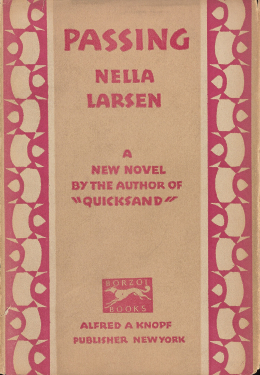
Passing is a novel by American author Nella Larsen, first published in 1929. Set primarily in the Harlem neighborhood of New York City in the 1920s, the story centers on the reunion of two childhood friends—Clare Kendry and Irene Redfield—and their increasing fascination with each other's lives. The title refers to the practice of "racial passing", which is a key element of the novel. Clare Kendry's attempt to pass as white for her husband, John (Jack) Bellew, is significant and is a catalyst for the tragic events.

Marie-Guillemine Benoist, born Marie-Guillemine Laville-Leroux, was a French neoclassical, historical, and genre painter.
Madame Atomos is the name of a fictional villain who appears in a book series of novels written by French writer André Caroff, a prolific author of popular adventure series, many of which include science fiction and horror elements.
Armance is a romance novel set during the Bourbon Restoration by French writer Stendhal, published anonymously in 1827. It was Stendhal's first novel, though he had published essays and critical works on literature, art, and travel since 1815.

Marie Charlotte Hippolyte de Saujon, by marriage Countess of Boufflers, was a French femme de lettres and salon hostess. Nicknamed "l'idole" by Madame du Deffand, she was a lady in waiting to the Duchess of Chartres and a mistress of Chartres' brother, the 6th Prince of Conti.

Portrait of Madame Récamier is an 1800 portrait of the Parisian socialite Juliette Récamier by Jacques-Louis David showing her in the height of Neoclassical fashion, reclining on a Directoire style sofa in a simple Empire line dress with almost bare arms, and short hair "à la Titus." The work is unfinished.

"The Wife of His Youth" is a short story by American author Charles W. Chesnutt, first published in July 1898. It later served as the title story of the collection The Wife of His Youth and Other Stories of the Color-Line. That book was first published in 1899, the same year Chesnutt published his short story collection The Conjure Woman.

Emma Azalia Hackley, also known as E. Azalia Hackley and Azalia Smith Hackley (1867–1922), was a concert soprano, newspaper editor, teacher, and political activist. An African American, she promoted racial pride through her support and promotion of music education for African Americans. She was a choir director and organized Folk Songs Festivals in African American churches and schools. Hackley studied music for years, including in Paris under opera singer Jean de Reszke. She was a music teacher who taught Roland Hayes, Marian Anderson, and R. Nathaniel Dett. She founded the Vocal Normal Institute in Chicago.
Sophie Doin, was a French novelist and essayist whose writings contributed to the renewal of abolitionism in France during the 1820s. She targeted abuses in the French colonies, most notably Guadeloupe and Martinique, where slavery continued for decades after the declaration of Haitian independence in 1804. In her various antislavery writings, notably the novel La Famille noire, ou la Traite de l’esclavage, she drew the French public's attention to the injustices committed by the slave system. She called for a more humane treatment of Blacks, for the abolition of the slave trade, and for religious and practical education that would prepare slaves for eventual emancipation.

I Am a Martinican Woman is a semi-autobiographical novel written by Lucette Céranus (1916–1955), under the pseudonym Mayotte Capécia, in the mid-twentieth century. It tells the story of Mayotte's childhood and young adulthood, including her relationship with a white officer who ultimately abandons her in Martinique with their son. The 1948 publication of this novel made Ceranus the first woman of color to publish a book in France. In 1949, the novel was awarded the Grandprix littéraire des Antilles.

Laure was an art model in France known for her work with artist Édouard Manet. She is best known for posing as the black maid offering the white nude figure a bouquet of flowers in Manet's 1863 painting Olympia.
Gisèle Hountondji is a writer, interpreter, and translator from Benin. She is considered the first Beninese woman writer. Her 1986 autobiographical novel Une citronnelle dans la neige recounts her often painful years as a student in Europe, particularly in Paris.

Portrait of Madeleine, also known as 'Portrait of a Black Woman', is an oil-on-canvas painting by the French artist Marie-Guillemine Benoist. It was exhibited at the Paris Salon in 1800, was acquired by Louis XVIII for the French state in 1818, and remains in the collection of the Louvre.














